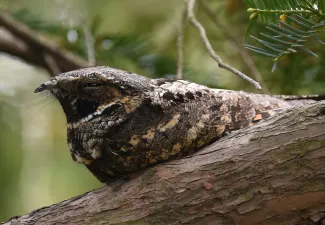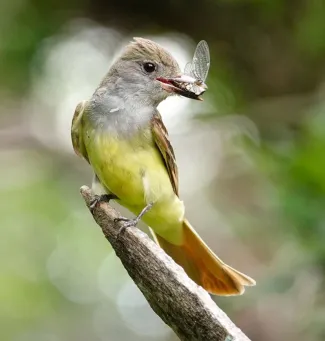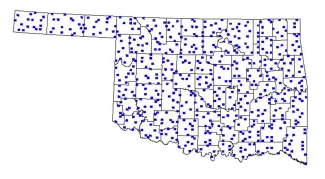One of the first steps in conserving Oklahoma’s fish and wildlife is documenting where the animals can be found, and how many can be found there. While this basic information is available for most game species, it is less broadly understood for species that aren’t hunted or fished. That’s why the Wildlife Department partners with universities and conservation groups to conduct field surveys of nongame species across their suspected ranges.
“Partnering with species experts makes our small Wildlife Diversity Program more impactful,” said Kurt Kuklinski, research supervisor for the Wildlife Department. “We can survey for more species, in more habitats, and ultimately learn more about our state’s incredible species in a shorter amount of time.”
Partner groups will launch three survey projects this spring, focusing on the whereabouts of species considered to be of greatest conservation need.
The Whip-poor-will’s Timeless Lullaby Will Captivate Surveyors for Three Years

Eastern whip-poor-will.
The enchanting nighttime calls of the whip-poor-will and its relatives are the best signatures of the vocal but well-camouflaged “nightjar” family. These familiar songs will be welcomed signs of spring and early summer for many Oklahomans while also alerting a survey team from Oklahoma State University to the presence of three bird species, the eastern whip-poor-will, common nighthawk, and Chuck-will’s-widow.
“We’ll be documenting every nightjar call we hear in our survey area, but we’re especially interested in the call of the rare and declining eastern whip-poor-will,” said Scott Loss, co-investigator for the project.
“Their call is similar to the more common and widespread Chuck-will's-widow, but the birds emphasize different notes of their respective four-note calls. Whip-poor-wills emphasize the first and last notes of their call, while Chuck-will's-widows emphasize the middle two notes,” said Matt Broadway, graduate research assistant for the project.
In addition to listening for and recording the presence of nightjars, the survey team will also be measuring the influence of the moon’s phase and other factors on the birds’ detection rates. “Studies in other states have indicated that the birds call throughout the night on nights surrounding the full moon but may only call close to dusk on nights surrounding a new moon,” Loss said. “We want to quantify that pattern in Oklahoma, and then use it to develop new protocols or adapt existing protocols for future survey efforts.”
Survey protocols will not only help with detection but will also help the survey team evaluate the species’ habitat needs, and over the long term, evaluate population trends.
The two-person survey team will listen for calling nightjars from publicly accessible roads in an eight-county area. Surveys will be conducted from 30 minutes after sunset to 30 minutes before sunrise during the birds’ breeding season for three seasons.
Nightjar surveys will be funded in part by State Wildlife Grant F21AF02650 and by Oklahoma State University.
Search Radius Expanded for a Crayfish Thought to be Confined to 30 Miles of the Kiamichi River
The Ouachita Mountains are a special place and include habitat for several species that live only in that ecoregion. One such species, the 2.5-inch-long Kiamichi crayfish, is thought to live only in a 30-mile stretch of the Kiamichi River in Oklahoma.
“A lot of what we know about this species is supposition,” said Quinton Phelps, the project’s principal investigator from Missouri State University. “The beauty of this project is that we’ll be able to confirm Kiamichi crayfish locations, learn what their suite of habitat needs are, and potentially expand their known range throughout the Kiamichi River watershed.”
After Phelps’s team resurveys the historic locations, they’ll measure the crayfish’s specific habitat preferences and build a predictive model to find nearby streams and rivers that may also provide suitable habitat for the crayfish. The team’s search radius will then be expanded to the newly identified sites within the state, and those stream’s crayfish communities will be documented.
“I have a lot of personal, deep connections to the natural resources of Oklahoma,” Phelps said. “This is the perfect opportunity for our Applied Fisheries Management Lab to partner with the Oklahoma Department of Wildlife Conservation and do good things for Oklahoma’s natural resources.”
Kiamichi crayfish surveys will be funded in part by State Wildlife Grant F21AF02707 and by Missouri State University.
Intensive Nesting Bird Surveys Slated for Entire State
The George Miksch Sutton Avian Research Center will be putting Oklahoma’s nesting birds on the map with their Oklahoma Breeding Bird Atlas project!

The second Oklahoma Breeding Bird Atlas gathers nesting records from selected survey blocks for many species of birds, including this great crested flycatcher bringing a cicada back to its tree cavity nest to feed a hungry brood of chicks. Photo by Dan Reinking/Sutton Center.
“Oklahoma has well over 200 nesting bird species, and keeping track of how their populations change over time requires large-scale, intensive surveys,” said Dan Reinking, the atlas’s principal investigator from the Sutton Center. “We’re excited to partner with the Wildlife Department to make this long-term bird monitoring project a reality for tracking Oklahoma bird populations.”
Reinking’s team of trained volunteer bird watchers will visit 583 survey blocks across the state during three nesting seasons to document as many species as they can find in each block and record any potential nesting behaviors.

Reinking’s survey team will visit nearly 600 survey blocks at least two times per nesting season for three nesting seasons.
“Gathering data for the whole diversity of nesting bird species in Oklahoma is the project goal, but it will also be exciting to discover any new species nesting in Oklahoma since the first breeding bird atlas project was completed in 2001.”
Reinking led Oklahoma’s first Breeding Bird Atlas effort from 1996 – 2001. Most state atlas projects are repeated at a 20 – 25-year interval, which can provide biologists with a long-term, if intermittent, metric of bird populations.
Nesting bird surveys will be funded in part by State Wildlife Grant F21AF03463 and by the Sutton Avian Research Center.
“Each of these surveys will generate new data about Oklahoma’s diverse wildlife communities,” Kuklinski said. “We’re excited to partner with these great cooperators and continue to build accessible knowledge of our state’s resources.”
The surveys will be funded by State Wildlife Grants, a U.S. Fish and Wildlife Service program that provides states with money to address conservation needs including surveys and habitat management. The Wildlife Department and its partners have successfully completed more than 100 of these grants, focusing on Oklahoma’s mammals, birds, fish, invertebrates, reptile, and amphibian species of greatest conservation need.